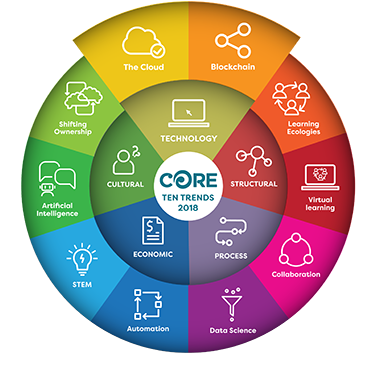The Cloud

What’s it about?
What is ‘the cloud’ and ‘a cloud-based service’?
Where we once considered the size of a computer’s hard drive on which our programs and data could be stored a critical part of any purchase decision, those things are increasingly delivered from “the cloud”.
The term ‘cloud’ originates from the symbol used by network engineers when they needed to represent the Internet. It has now become synonymous with the Internet itself. A cloud-based service is anything that is made available to a device with an internet connection, delivered by somebody else’s computing resource. We typically think of devices such as smartphones and computers connecting to cloud services, but increasingly devices ranging from watches and other wearables through to appliances from light bulbs to cars and a raft of sensors like cameras will be cloud-connected to form the ‘Internet of Things’.
Giant companies such as Amazon, Apple, Microsoft, Facebook, and Google have most the Cloud market and have the scale to build colossal data centres. An increasing range of smaller, specialised providers deliver services built on their own or on these companies’ platforms. Services are delivered for free in some cases, or, more commonly, as a paid subscription.
SaaS or IaaS?
Software as a Service (SaaS), in which software applications are run from data centres rather than on individual computers or servers, has become the dominant model for using the cloud to deliver services to schools. Examples include Google’s G Suite, Microsoft’s Office 365, student management systems like eTap and Edge, and Xero’s accounting system. Merely using somebody else’s infrastructure to run the same services that used to be on a school’s server — known as Infrastructure as a Service (IAAS) — does not leverage enough of the benefits of cloud computing to make it worthwhile for most schools, because there is still too much technical expertise required to implement and maintain IAAS solutions. SaaS will inevitably render school servers redundant.
What’s driving this?
Some common ways that the cloud can directly or indirectly enable and support learning include:
Connectedness
Learners can accomplish tasks and interact with up-to-date resources, people, and knowledge regardless of location, time of day, or device.
Before the cloud, access to resources was limited to what a school might be able to provide, for example, in terms of books, TV, or radio broadcasts, or guest speakers. The cloud has radically changed this and will continue to do so as local and global connectivity increases to enable all learners to participate in an increasing range of learning activities online.
Performance
Improved communication, collaboration, flexibility, productivity, and creativity
The ability for multiple people to synchronously or asynchronously collaborate online, for example, will continue to have clear benefits for staff and students as we shift from a focus on individual to team performance. Administrative headaches like remembering to back up or hit the save button have been alleviated.
Economics
Reduced costs with improved technical capabilities, reliability, and security
The ‘utility model’ of procuring and consuming cloud services as a subscription means services can more readily be added or dropped, making schools more agile to meet the changing needs of their teachers and students in a rapidly changing society. Schools can subscribe to multiple cloud services. Budgeting becomes more about managing a list of subscriptions and less about trying to predict when hardware and software will need to be replaced and grappling with big-impact decisions about what to replace them with.
What examples of this can I see?
Schools are embracing using the cloud because it enables them to care less about keeping technology running but instead to focus on what can be done with the technology to benefit learners. But, to continue growing the uptake of the cloud, there are some challenges to overcome:
- Performance - How can more demanding tasks such as multimedia production, data manipulation, and graphic design be made possible without expensive end-user devices running specialist software?
- Identity - How can staff and students have fewer usernames and passwords to gain access to cloud services whilst more surely verifying their identity?
- Security - Can schools trust cloud service providers to secure their data? Are schools following best practices themselves when it comes to security of cloud services?
- Ubiquity - Can the devices and connectivity needed to access cloud services be provided with the quantity, ease, reliability, capability and price that makes them available to all?
- Privacy - Can we be confident that our privacy is being respected as data is transferred and stored in the cloud?
- Portability - How can we ensure data is able to flow as students and teachers transition between schools or as formats and technologies shift?
- Technical support - Can technical support change from being focussed on configuring and maintaining infrastructure to being focused on integrating cloud services so that technicians are tasked with bringing together discrete services rather than trying to create a whole ecosystem?
How might we respond?
Some questions to act as a stimulus with your colleagues include:
- What cloud-based applications are currently used by teachers and students in your organisation?
- What issues are you currently experiencing in your school’s technology set up that could be addressed by moving services to the cloud?
- How can the use of cloud-based services support student learning at your school? What examples of this come to mind?
- How could the use of cloud-based services support the administrative tasks at your school?
- What benefits could there be at a cluster level if you are participating in a Community of Learning | Kāhui Ako?
- Are you considering the risks associated with the cloud services you already use? Do you have contingencies in place if the cloud becomes unavailable due to an outage?
- In what ways are you preparing students to move beyond being consumers of the cloud, to become creators of future cloud services?
How do you think the challenges outlined above are being addressed in your school?